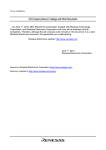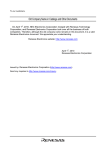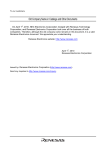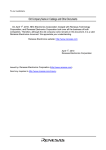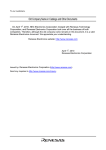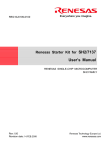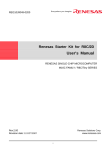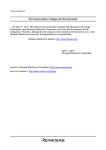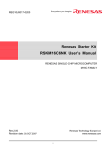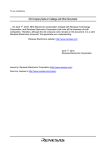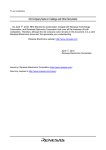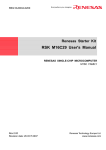Download Renesas Renasas Single-Chip Microcomputer SH7086 User`s manual
Transcript
REG10J0125-0100 Renesas Starter Kit for SH7211 User's Manual RENESAS SINGLE-CHIP MICROCOMPUTER SuperHTM RISC engine Rev.1.00 Revision date:17.Jan.2008 Renesas Technology Europe Ltd. www.renesas.com Table of Contents Chapter 1. Preface ..................................................................................................................................................1 Chapter 2. Purpose .................................................................................................................................................2 Chapter 3. Power Supply ........................................................................................................................................3 3.1. Requirements ...............................................................................................................................................3 3.2. Power – Up Behaviour .................................................................................................................................3 Chapter 4. Board Layout .........................................................................................................................................4 4.1. Component Layout .......................................................................................................................................4 4.2. Board Dimensions ........................................................................................................................................5 Chapter 5. Block Diagram .......................................................................................................................................6 Chapter 6. User Circuitry.........................................................................................................................................7 6.1. Switches .......................................................................................................................................................7 6.2. LEDs.............................................................................................................................................................7 6.3. Potentiometer ...............................................................................................................................................7 6.4. Serial port .....................................................................................................................................................7 6.5. LCD Module..................................................................................................................................................8 6.6. Option Links..................................................................................................................................................9 6.7. Oscillator Sources ......................................................................................................................................13 6.8. Reset Circuit ...............................................................................................................................................13 Chapter 7. Modes..................................................................................................................................................14 7.1.1. Boot mode............................................................................................................................................14 7.1.2. User Mode ...........................................................................................................................................14 Chapter 8. Programming Methods........................................................................................................................15 Chapter 9. Headers...............................................................................................................................................16 9.1. Microcontroller Headers .............................................................................................................................16 9.2. Application Headers ...................................................................................................................................20 Chapter 10. Code Development ...........................................................................................................................24 10.1. Overview...................................................................................................................................................24 10.2. Compiler Restrictions ...............................................................................................................................24 10.3. Breakpoint Support...................................................................................................................................24 10.4. Memory Map.............................................................................................................................................25 Chapter 11. Component Placement ......................................................................................................................26 Chapter 12. Additional Information........................................................................................................................27 ii Chapter 1. Preface Cautions This document may be, wholly or partially, subject to change without notice. All rights reserved. No one is permitted to reproduce or duplicate, in any form, a part or this entire document without the written permission of Renesas Technology Europe Limited. Trademarks All brand or product names used in this manual are trademarks or registered trademarks of their respective companies or organisations. Copyright © Renesas Technology Europe Ltd. 2008. All rights reserved. © Renesas Technology Corporation. 2008. All rights reserved. © Renesas Solutions Corporation. 2008. All rights reserved. Website: http://www.renesas.com/ Glossary ADC Analog to Digital Converter USB Universal Serial Bus CPU Central Processing Unit DAC Digital to Analog Converter DMA Direct Memory Access E10A “E10A for Starter Kit” debugger FDT Flash Development Tool RSK Renesas Starter Kit LED Light Emitting Diode LCD Liquid Crystal Display 1 Chapter 2. Purpose This RSK is an evaluation tool for Renesas microcontrollers. Features include: • Renesas Microcontroller Programming. • User Code Debugging. • User Circuitry such as switches, LEDs and potentiometer(s). • Sample Application. • Sample peripheral device initialisation code. The CPU board contains all the circuitry required for microcontroller operation. This manual describes the technical details of the RSK hardware. The Quick Start Guide and Tutorial Manual provide details of the software installation and debugging environment. 2 Chapter 3. Power Supply 3.1. Requirements This CPU board operates from a 5V power supply. A diode provides reverse polarity protection only if a current limiting power supply is used. The kit is supplied with an E10A debug module and a PSU. When the CPU board is connected to another system that system should supply power to the CPU board. All CPU boards have an optional centre positive supply connector using a 2.0mm barrel power jack which is compatible with the supplied PSU. Warning The CPU board is neither under not over voltage protected. Use a centre positive supply for this board. 3.2. Power – Up Behaviour When the RSK is purchased the CPU board has the ‘Release’ or stand alone code from the example tutorial code pre-programmed into the Renesas microcontroller. On powering up the board the user LEDs will start to flash. Pressing any switch will cause the LEDs to flash at a rate controlled by the potentiometer. 3 Chapter 4. Board Layout 4.1. Component Layout The following diagram shows top layer component layout of the board. Application Board Interface JA5 Reset Switch RS232 Serial JA1 LCD Display Power Power LED J1 Microcontroller Pin Headers BUS Interface E8 Header J2 J4 J A 3 User LEDs E10A Header J3 JA6 JA2 Boot LED Potentiometer User Switches Application Board Interface Figure 4-1: Board Layout 4 4.2. Board Dimensions The following diagram gives the board dimensions and connector positions. All through hole connectors are on a common 0.1” grid for easy interfacing. 120.00mm 115.00mm 86.36mm Short Board = 85 mm Corners x4 3mm radius 50.80 mm 43.18 mm 35.56 mm 27.00mm SW 1 SW 2 SW 3 POT JA2 E10A JA6 J3 - Applies to connector with micriocontroller pin1 J4 MCU J2 E8 J1 Serial D9 SKT R E S JA5 JA1 45.00mm Figure 4-2 : Board Dimensions 5 Chapter 5. Block Diagram Figure 5-1 shows the CPU board components and their connectivity. Figure 5-1: Block Diagram Figure -5-2 shows the connections to the RSK. Figure -5-2 : RSK Connections 6 Chapter 6. User Circuitry 6.1. Switches There are four switches located on the CPU board. The function of each switch and its connection are shown in Table 6-1. Switch Function RES SW1/BOOT* Microcontroller When pressed; the CPU board microcontroller is reset. RESn, Pin 22 Connects to an IRQ input for user controls. IRQ0, Pin 92 (Port B, bit 21) SW2* Connects to an IRQ line for user controls. IRQ4, Pin 87 (Port B, bit 18) SW3* Connects to an IRQ line for user controls. Same pin functions as ADC IRQ6, Pin 88 trigger input. (Port B, bit 19) Table 6-1: Switch Functions *Refer to schematic for detailed connectivity information. 6.2. LEDs There are six LEDs on the CPU board. The green ‘POWER’ LED lights when the board is powered. The orange BOOT LED indicates the device is in BOOT mode when lit. The four user LEDs are connected to an IO port and will light when their corresponding port pin is set low. Table 6-2, below, shows the LED pin references and their corresponding microcontroller port pin connections. LED Reference (As Microcontroller Port Pin Microcontroller Pin Polarity shown on silkscreen) function Number LED0 Port B bit 10 75 Active Low LED1 Port B bit 11 76 Active Low LED2 Port B bit 12 79 Active Low LED3 Port B bit 13 80 Active Low Table 6-2: LED Port 6.3. Potentiometer A single turn potentiometer is connected to pin ‘AN0’ of the microcontroller. This may be used to vary the input analog voltage value to this pin between AVCC and Ground. 6.4. Serial port The microcontroller programming serial port (SCI1) is connected to the E8 connector. SCI2 is connected to the RS232 connector SERIAL. SCI1 can optionally be connected to the RS232 transceiver by fitting option resistors. The connections to be fitted are listed in Table 6-3 7 Description Function Fit for RS232 Remove for Fit for E8a Remove for E8a RS232 TxD1 Programming Serial Port R47 R21, R56 R21 R47,R56 RxD1 Programming Serial Port R38 R20,R48 R20 R38,R48 Table 6-3: Serial Option Links The board is designed to accept a straight through RS232 cable. 6.5. LCD Module The LCD module supplied with the RSK can be connected to the connector ‘LCD’ for use with the tutorial code. Any module that conforms to the pin connections and has a KS0066u compatible controller can be used. The LCD module uses a 4 bit interface to reduce the pin allocation. No contrast control is provided; this must be set on the display module. Table 6-4 shows the pin allocation and signal names used on this connector. The module supplied with the CPU board only supports 5V operation. LCD Pin Circuit Net Name Device Pin Circuit Net Name Device Pin Pin 1 Ground - 2 5V Only - 3 No Connection - 4 DLCDRS 112 5 R/W (Wired to Write only) - 6 DLCDE 111 7 No Connection - 8 No connection - 9 No Connection - 10 No connection - 11 DLCD4 63 12 DLCD5 65 13 DLCD6 66 14 DLCD7 67 Table 6-4: LCD Module Connections 8 6.6. Option Links Table 6-5 below describes the function of the option links contained on this CPU board. The default configuration is indicated by BOLD text. Option Link Settings Reference R20 R21 R32 R38 R40 R42 R47 R48 R52 R55 R56 R58 R59 Function Fitted Alternative ( Removed ) Related To Serial Port Connects programming port Disconnects programming port (Rx) from R38, R42, Configuration (Rx) to E8 connector. E8 connector. R48 Serial Port Connects programming port Disconnects programming port (Tx) from R47, R55, Configuration (Tx) to E8 connector. E8 connector. R56 Serial Port Connects serial port RXD0 to Disconnects serial port RXD0 from R52 Configuration RS232 Buffer. SERIAL D-type connector. Serial Port Connects programming port (Rx) Disconnects programming port (Rx) to R20, R42, Configuration to external serial connectors. external serial connectors. R48 Serial Port Disables RS232 Serial Enables RS232 Serial - Configuration Transceiver Transceiver Serial Port Routes RS232 serial port Rx to Disconnects RS232 serial port Rx from Configuration application connector (JA6). application connector (JA6). Serial Port Connects programming port (Tx) Disconnects programming port (Tx) to R34, R20, Configuration to external connectors. external serial connectors. R22 Serial Port Connects Alternate serial (CH2) Disconnects Alternate serial from D R20, R38, Configuration to D connector connector. R42 Serial Port Connects serial port TXD0 to Disconnects serial port TXD0 from R32 Configuration RS232 Buffer. SERIAL D-type connector. Serial Port Routes RS232 serial port Tx to Disconnects RS232 serial port Tx from Configuration application connector (JA6). application connector (JA6). Serial Port Connects Alternate serial (CH2) Disconnects Alternate serial from D R21,R47, Configuration to D connector connector. R57 Serial Port Connects Alternate serial (CH0) to Disconnects Alternate serial from D R59 Configuration D connector connector. Serial Port Connects Alternate serial (CH0) to Disconnects Alternate serial from D Configuration D connector connector. Table 6-5: Serial configuration links 9 R48, R38 R4, R56 R58 Table 6-6 below describes the function of the option links associated with Power configuration. The default configuration is indicated by BOLD text. Option Link Settings Reference R4 R11 Function Power Source Power Source Fitted Alternative ( Removed ) Board can be powered from Disconnects the supply from PWR PWR connector. connector. Board can be powered by E8a Disconnects the supply from E8 Related To R11, R28 R4, R8 connector. R22 R27 R28 Microcontroller E8A_VCC2 can drive E8A_VCC2 disconnected from Power Supply microcontroller core microcontroller core. Microcontroller Regulated 1V5 can drive Regulated 1V5 disconnected from Power Supply microcontroller core microcontroller core. Power Board input power connected Disconnects the supply from Con_5V R4, R11 Fit Low ohm resistor to measure current. R53 Disconnect Board_VCC from CON_3V3 R49 Connects regulated 3V3 voltage Disconnects regulated 3V3 voltage R45 source to Board_VCC. source from Board_VCC. Microcontroller Core Supply power to Fit Low ohm resistor to measure current. Power Supply Microcontroller. R27 R22 to CON_5V R44 R45 Microcontroller I/O Supply power to Power Supply Microcontroller. Power Connects Board_VCC to CON_3V3. R49 R53 Power Source R44 Table 6-6: Power configuration links Table 6-7 below describes the function of the option links associated with Analog configuration. The default configuration is indicated by BOLD text. Option Link Settings Reference R60 Function Fitted Alternative ( Removed ) Related To Connects AVCC to Board_5V Disconnects AVCC from CON_VREF. Analog Voltage Links analog ground to digital Isolates analog ground from digital Source ground. ground. Analog Voltage Connects AVCC to CON_VREF Disconnects AVCC from CON_VREF. R60 Connects Board_5V to VREF Disconnects Board_5V from VREF. R77 Voltage Reference Connects CON_VREF Disconnects CON_VREF from VREF R73 Source to VREF Analog Voltage R71 Source R70 R71 Source R73 Voltage Reference Source R77 Table 6-7: Analog configuration links 10 Table 6-8 below describes the function of the option links associated with Pin function configuration. The default configuration is indicated by BOLD text. Option Link Settings Reference Function Fitted Alternative ( Removed ) Related To R61 Pin function select Connects PIN 109 to RxD2 on JA6. Disconnects PIN 109 from RxD2. R126 R62 Pin function select Connects PIN 110 to TxD2 on JA6. Disconnects PIN 110 from TxD2. R119 R63 Pin function select Connects PIN 80 to LED3. Disconnects PIN 80 from LED3. R105 R64 Pin function select Connects PIN 115 to M1_Vn on JA2. Disconnects PIN 115 from M1_Vn. R93 R65 Pin function select Connects PIN 79 to LED2. Disconnects PIN 79 from LED2. R108 R66 Pin function select Connects PIN 76 to LED1. Disconnects PIN 76 from LED1. R116 R67 Pin function select Connects PIN 75 to LED0. Disconnects PIN 75 from LED0. R118 R68 Pin function select Connects PIN 82 to CS5n on JA3. Disconnects PIN 82 from CS5n. R78 R69 Pin function select Connects PIN 72 to WE1n on JA3. Disconnects PIN 72 from WE1n. R125 R72 Pin function select Connects PIN 60 to TxD0 on JA2. Disconnects PIN 60 from TxD0. R122 R74 Pin function select Connects PIN 59 to RxD0 on JA2. Disconnects PIN 59 from RxD0. R123 R75 Pin function select Connects PIN 6 to TIOC0B on JA5. Disconnects PIN 6 from TIOC0B. R124 R76 Pin function select Connects PIN 81 to ADTRGn on JA1. Disconnects PIN 81 from ADTRGn. R117 R79 Pin function select Connects PIN 97 to AN0 on JA1. Disconnects PIN 97 from AN0. R84 R80 Pin function select Connects PIN 8 to TIOC0D on JA5. Disconnects PIN 8 from TIOC0D. R120 R81 Pin function select Connects PIN 7 to TIOC0C on JA5. Disconnects PIN 7 from TIOC0C. R127 R82 Pin function select Connects PIN 117 to M1_Up on JA2. Disconnects PIN 117 from M1_Up. R88, R103 R83 Pin function select Connects PIN 120 to M1_Un on JA2. Disconnects PIN 120 from M1_Un. R91, R111 R84 Pin function select Connects PIN 97 to AD_POT. Disconnects PIN 97 from AD_POT. R79 R86 Pin function select Connects PIN 116 to M1_Vp on JA2. Disconnects PIN 116 from M1_Vp. R96, R113 R87 Pin function select Connects PIN 70 to M1_Wp on JA2. Disconnects PIN 70 from M1_Wp. R95 R88 Pin function select Connects PIN 117 to TMR0 on JA2. Disconnects PIN 117 from TMR0. R82, R103 R91 Pin function select Connects PIN 120 to TMR1 on JA2. Disconnects PIN 120 from TMR1. R83, R111 R93 Pin function select Connects PIN 115 to TRIGa on JA2. Disconnects PIN 115 from JA2. R64 R95 Pin function select Connects PIN 70 to IRQ7 on JA1. Disconnects PIN 70 from IRQ7. R87 R96 Pin function select Connects PIN 116 to TRIGb on JA2. Disconnects PIN 116 from TRIGb. R86, R113 R103 Pin function select Connects PIN 117 to DACK0 on JA6. Disconnects PIN 117 from DACK0. R82, R88 R105 Pin function select Connects PIN 80 to M2_Up on . Disconnects PIN 80 from M2_Up. R63 R108 Pin function select Disconnects PIN 79 from M2_Un. R65 Connects PIN 79 to M2_Un on JA5. 11 Option Link Settings Reference Function Fitted Alternative ( Removed ) Related To R111 Pin function select Connects PIN 120 to DREQ0 on JA6. Disconnects PIN 120 from DREQ0. R83, R91 R113 Pin function select Connects PIN 116 to DTEND0 on JA6. Disconnects PIN 116 from DTEND0. R86, R96 R116 Pin function select Connects PIN 76 to M2_Vp on JA5. Disconnects PIN 76 from M2_Vp. R66 R117 Pin function select Connects PIN 81 to M2_TRISTn on Disconnects R76 PIN 81 from M2_TRISTn. JA5. R118 Pin function select Connects PIN 75 to M2_Vn on JA5. Disconnects PIN 75 from M2_Vn. R67 R119 Pin function select Connects PIN 110 to TCLKC on JA5. Disconnects PIN 110 from TCLKC. R62 R120 Pin function select Connects PIN 8 to PTTX on JA6. Disconnects PIN 8 from PTTX. R80 R122 Pin function select Connects PIN 60 to WRn on JA3. Disconnects PIN 60 from WRn. R72 R123 Pin function select Connects PIN 59 to RDn on JA3. Disconnects PIN 59 from RDn. R74 R124 Pin function select Connects PIN 6 to SCK1 on JA6. Disconnects PIN 6 from SCK1. R75 R125 Pin function select Connects PIN 72 to M2_Wp on JA5. Disconnects PIN 72 from M2_Wp. R69 R126 Pin function select Connects PIN 109 to TCLKD on JA5. Disconnects PIN 109 from TCLKD. R61 R127 Pin function select Connects PIN 7 to PTRX on JA6. Disconnects PIN 7 from PTRX. R81 R128 Pin function select Connects PIN 71 to WE0n on JA3. Disconnects PIN 71 from WE0n. R132 R132 Pin function select Connects PIN 71 to M2_Wn on JA5. Disconnects PIN 71 from M2_Wn. R128 Table 6-8: Pin function select links Table 6-9 below describes the function of the option links associated with Clock configuration. The default configuration is indicated by BOLD text. Option Link Settings Reference Function Fitted Alternative ( Removed ) Related To R75 Clock Oscillator Parallel resistor for crystal Not fitted - R76 Clock Oscillator Connects on board clock to MCU External Clock Source can be connected. R74, R77, R108 R108 Clock Oscillator Connects on board clock to MCU External Clock Source can be connected. R74, R77, R76 R74 Clock Oscillator Connects external clock to MCU Disconnects external clock connection R77, R76 to MCU R77 Clock Oscillator Connects external clock to MCU Disconnects external clock connection to MCU Table 6-9: Clock configuration links 12 R74, R76 6.7.Oscillator Sources A crystal oscillator is fitted on the CPU board and used to supply the main clock input to the Renesas microcontroller. Table 6-10: Oscillators / Resonators details the oscillators that are fitted and alternative footprints provided on this CPU board: Component Crystal (X1) Fitted 10MHz (HC49/4H package) Table 6-10: Oscillators / Resonators Warning: When replacing the default oscillator with that of another frequency, the debugging monitor will not function unless the following are corrected: • FDT programming kernels supplied are rebuilt for the new frequency 6.8.Reset Circuit The CPU Board includes a simple latch circuit that links the mode selection and reset circuit. This provides an easy method for swapping the device between Boot Mode and User mode. This circuit is not required on customers’ boards as it is intended for providing easy evaluation of the operating modes of the device on the RSK. Please refer to the hardware manual for more information on the requirements of the reset circuit. The reset circuit operates by latching the state of the boot switch (SW1) on pressing the reset button. This control is subsequently used to modify a port pin state to select which code is executed. The reset is held in the active state for a fixed period by a pair of resistors and a capacitor. Please check the reset requirements carefully to ensure the reset circuit on the user’s board meets all the reset timing requirements. 13 Chapter 7.Modes The CPU board can be configured in User mode and Boot mode. User mode may be used to run and debug user code, while Boot mode may only be used to program the Renesas microcontroller with program code via the SCI1 interface. Further details of programming the flash are available in the SH7211 device hardware manual. The CPU board provides the capability of changing between User and Boot / User Boot modes using a simple latch circuit. This is only to provide a simple mode control on this board when the E10A debugger is not in use. To manually enter boot mode, press and hold the SW1/BOOT. The mode pins are held in their boot states while reset is pressed and released. Release the boot button. The BOOT LED will be illuminated to indicate that the microcontroller is in boot mode. More information on the operating modes can be found in the device hardware manual. 7.1.1. Boot mode The boot mode settings for this CPU board are shown in Table 7-1 below: FWE MD1 MD0 LSI State after Reset End 1 0 0 Boot Mode Table 7-1: Mode pin settings 7.1.2. User Mode The SH7086 supports various user modes. The default user mode for the RSKSH7211 is mode 6. FWE MD1 MD0 LSI State after Reset End 1 1 0 User Mode Table 7-2: Mode pin settings 14 Chapter 8. Programming Methods The board is intended for use with HEW and the supplied E10A debugger only. Please refer to SH7211 Group Hardware Manual for details of the programming methods using on-chip serial port SCI1 and without using E10A debugger. 15 Chapter 9. Headers 9.1. Microcontroller Headers Table 9-1 to Table 9-4 show the microcontroller pin headers and their corresponding microcontroller connections. The header pins connect directly to the microcontroller pin unless otherwise stated. J1 Pin Circuit Net Name Device Pin Pin Circuit Net Name Device Pin 1 A18 1 19 WDT_OVFn 19 2 A19 2 20 VCC 20 3 A20 3 21 GND 21 4 A21 4 22 RESn 22 5 A22 5 23 FWE 23 6 SCK1_TIOC0B 6 24 GND 24 7 PTRX_TIOC0C 7 25 CON_XTAL 25 8 PTTX_TIOC0D 8 26 CON_EXTAL 26 9 VCCQ 9 27 GND 27 10 GND 10 28 VCCQ 28 11 NMI 11 29 ASEMDn 29 12 TDI 12 30 ASEBRKn 30 MD_CLK0 31 32 13 VCC 13 31 14 GND 14 32 MD_CLK2 15 TDO 15 33 MD0 33 MD1 34 16 TCK 16 34 17 TMS 17 35 VCC 35 18 TRSTn 18 36 GND 36 Table 9-1: J1 microcontroller header 16 J2 Pin Circuit Net Name Device Pin Pin Circuit Net Name Device Pin 1 D0 37 19 GND 55 2 D1 38 20 D13 56 3 D2 39 21 D14 57 4 D3 40 22 D15 58 5 GND 41 23 RDn_RxD0 59 6 VCCQ 42 24 WRn_TxD0 60 7 D4 43 25 GND 61 8 D5 44 26 VCC 62 9 D6 45 27 DLCD4 63 10 D7 46 28 DLCD5 64 11 VCC 47 29 DLCD6 65 12 GND 48 30 DLCD7 66 13 D8 49 31 VCCQ 67 14 D9 50 32 GND 68 15 D10 51 33 M1_Wn 69 16 D11 52 34 M1Wp_IRQ7 70 17 D12 53 35 WE0n_M2Wn 71 18 VCCQ 54 36 WE1n_M2Wp 72 Table 9-2: J2 microcontroller header 17 J3 Pin Circuit Net Name Device Pin Pin Circuit Net Name Device Pin 1 VCC 73 19 M1_TRISTn 91 2 GND 74 20 IRQ0 92 3 LED0_M2Vn 75 21 AVSS 93 4 LED1_M2Vp 76 22 AVCC 94 5 GND 77 23 DA1 95 6 VCCQ 78 24 DA0 96 7 LED2_M2Un 79 25 ADPOT_AN0 97 8 LED3_M2Up 80 26 AN1 98 9 ADTRGn_M2TRISTn 81 27 AN2 99 10 CS5n_UD 82 28 AN3 100 11 CS1n 83 29 AN4 101 12 CS3n 84 30 AN5 102 13 VCC 85 31 AN6 103 104 14 GND 86 32 AN7 15 IRQ4 87 33 AN8 105 16 IRQ6 88 34 AVSS 106 17 GND 89 35 PIN107 107 18 VCCQ 90 36 PIN108 108 Table 9-3: J3 microcontroller header 18 J4 Pin Circuit Net Name Device Pin Pin Circuit Net Name Device Pin 1 RXD2_TCLKD 109 19 A4 127 2 TXD2_TCLKC 110 20 A5 128 3 DLCDE 111 21 A6 129 4 DLCDRS 112 22 A7 130 5 GND 113 23 GND 131 6 VCCQ 114 24 VCC 132 7 M1Vn_TRIGa 115 25 A8 133 8 M1Vp_DTEND0_TRIGb 116 26 A9 134 9 M1Up_DACK0_TMR0 117 27 A10 135 10 GND 118 28 A11 136 11 VCC 119 29 A12 137 12 M1Un_DREQ0_TMR1 120 30 A13 138 13 A0 121 31 VCCQ 139 14 A1 122 32 GND 140 15 A2 123 33 A14 141 16 VCCQ 124 34 A15 142 17 GND 125 35 A16 143 18 A3 126 36 A17 144 Table 9-4: J4 microcontroller header 19 9.2. Application Headers Table 9-5 to Table 9-9 below show the standard application header connections. * marks pins where a link to the microcontroller pin is via a fitted 0R link ** marks pins where a link to the microcontroller pin is via a fitted 100R link JA1 Pin Header Name CPU board Device Pin Pin Header Name Signal Name CPU board Device Pin Signal Name 1 5V CON_5V --- 14 DAC1 DA1 95 2 0V(5V) GROUND --- 15 IO_0 --- --- 3 3V3 CON_3V3 --- 16 IO_1 --- --- 4 0V(3V3) GROUND --- 17 IO_2 --- --- 5 AVcc CON_AVCC 94 18 IO_3 --- --- 6 AVss AVSS 93 19 IO_4 --- --- 7 AVref CON_VREF 105 20 IO_5 --- --- 8 ADTRG ADTRGn 81* 21 IO_6 --- --- 9 AD0 AN0 97* 22 IO_7 --- --- 10 AD1 AN1 98 23 IRQ3 IRQ7 70* 11 AD2 AN2 99 24 IIC_EX --- --- 12 AD3 AN3 100 25 IIC_SDA IIC_SDA 108** 13 DAC0 DA0 96 26 IIC_SCL IIC_SCL 107** Table 9-5 JA1 Standard Generic Header 20 JA2 Pin Header Name CPU board Device Pin Pin Header Name Signal Name CPU board Device Pin Signal Name 1 RESn RESn 22 14 Un M1_Un 120* 2 EXTAL CON_EXTAL 26* 15 Vp M1_Vp 116* 3 NMIn NMI 11 16 Vn M1_Vn 115* 4 Vss1 GROUND 14 17 Wp M1_Wp 70* 5 WDT_OVF WDT_OVFn 19 18 Wn M1_Wn 69* 6 SCIaTX TxD0 60* 19 TMR0 TMR0 117* 7 IRQ0 IRQ0 92 20 TMR1 TMR1 120* 8 SCIaRX RXD0 59* 21 TRIGa TRIGa 115* 9 IRQ1 IRQ1n 87 22 TRIGb TRIGb 116* 10 SCIaCK SCK0 --- 23 IRQ2 IRQ6 88 11 UD UD 82* 24 TRISTn M1_TRISTn 91 12 CTSRTS --- --- 25 Reserved 13 Up M1_Up 117* 26 Reserved Table 9-6: JA2 Standard Generic Header 21 JA3 Pin Header Name CPU board Device Pin Pin Header Name Signal Name CPU board Device Pin Signal Name 1 Address Bus A0 121 26 Read/Write Control WRn 60* 2 Address Bus A1 122 27 Memory Select CS1n 83 3 Address Bus A2 123 28 Memory Select CS3n 84 4 Address Bus A3 126 29 Data Bus D8 49 5 Address Bus A4 127 30 Data Bus D9 50 6 Address Bus A5 128 31 Data Bus D10 51 7 Address Bus A6 129 32 Data Bus D11 52 8 Address Bus A7 130 33 Data Bus D12 53 9 Address Bus A8 133 34 Data Bus D13 56 10 Address Bus A9 134 35 Data Bus D14 57 11 Address Bus A10 135 36 Data Bus D15 58 12 Address Bus A11 136 37 Address Bus A16 143 13 Address Bus A12 137 38 Address Bus A17 144 14 Address Bus A13 138 39 Address Bus A18 1 15 Address Bus A14 141 40 Address Bus A19 2 16 Address Bus A15 142 41 Address Bus A20 3 17 Data Bus D0 37 42 Address Bus A21 4 18 Data Bus D1 38 43 Address Bus A22 5 19 Data Bus D2 39 44 External Device Clock --- --- 20 Data Bus D3 40 45 Memory Select CS5n 82* 21 Data Bus D4 43 46 Bus Control --- --- 22 Data Bus D5 44 47 Data Bus Strobe WE1n 72* 23 Data Bus D6 45 48 Data Bus Strobe WE0n 71* 24 Data Bus D7 46 49 Reserved 25 Read/Write Control RDn 59* 50 Reserved Table 9-7: JA3 Standard Generic Header 22 JA5 Pin Header Name CPU board Device Pin Pin Header Name Signal Name CPU board Device Pin Signal Name 1 AD4 AN4 101 13 TIOC0A TIOC0B 6 2 AD5 AN5 102 14 TIOC0B TIOC0C 7 3 AD6 AN6 103 15 TIOC0C TIOC0D 8 4 AD7 AN7 104 16 M2_TRISTn M2_TRISTn 81 5 CAN1TX --- --- 17 TCLKC TCLKC 110 6 CAN1RX --- --- 18 TCLKD TCLKD 109 7 CAN2TX --- --- 19 M2_Up M2_Up 80 8 CAN2TX --- --- 20 M2_Un M2_Un 79 9 AD8 --- --- 21 M2_Vp M2_Vp 76 10 AD9 --- --- 22 M2_Vn M2_Vn 75 11 AD10 --- --- 23 M2_Wp M2_Wp 72 12 AD11 --- --- 24 M2_Wn M2_Wn 71 Table 9-8: JA5 Standard Generic Header JA6 Pin Header Name CPU board Device Pin Pin Header Name Signal Name CPU board Signal Name 1 DREQ DREQ0 120 13 Reserved 2 DACK DACK0 117 14 Reserved 3 TEND DTEND0 116 15 Reserved 4 STBYn --- --- 16 Reserved 5 RS232TX RS232TX --- 17 Reserved 6 RS232RX RS232RX --- 18 Reserved 7 SCIbRX RxD2 109* 19 Reserved 8 SCIbTX TxD2 110* 20 Reserved 9 SCIcTX PTTX 8 21 Reserved 10 SCIbCX --- --- 22 Reserved 11 SCIcCK SCK1 6 23 Reserved 12 SCIcRX PTRX 7 24 Reserved Table 9-9: JA6 Standard Generic Header 23 Device Pin Chapter 10. Code Development 10.1. Overview Note: For all code debugging using Renesas software tools, the CPU board must either be connected to a PC serial port via a serial cable or a PC USB port via an E10A. An E10A is supplied with the RSK product. Due to the continuous process of improvements undertaken by Renesas the user is recommended to review the information provided on the Renesas website at www.renesas.com to check for the latest updates to the Compiler and Debugger manuals. 10.2. Compiler Restrictions The compiler supplied with this RSK is fully functional for a period of 60 days from first use. After the first 60 days of use have expired, the compiler will default to a maximum of 256k code and data. To use the compiler with programs greater than this size you will need to purchase the full tools from your distributor. Warning: The protection software for the compiler will detect changes to the system clock. Changes to the system clock back in time may cause the trial period to expire prematurely. 10.3.Breakpoint Support This RSK is supplied with E10A emulator which supports breakpoints in ROM. For more details on breakpoints & E10A functions please refer to ‘SuperH Family E10A-USB Emulator User’s Manual’. 24 10.4.Memory Map The memory map shown in this section visually describes the locations of the each memory areas when operating the RSK in the default mode (Mode 6). Figure 10-1: Memory Map 25 Chapter 11. Component Placement Figure 11-1: Component Placement (Top Layer) 26 Chapter 12. Additional Information For details on how to use High-performance Embedded Workshop (HEW), refer to the HEW manual available on the CD or installed in the Manual Navigator. For information about the SH7211 microcontrollers refer to the SH7211 Group Hardware Manual. For information about the SH7211 assembly language, refer to the SH-2A, SH2A-FPU Software Manual. For information about the E10A Emulator, please refer to the SH Family E10A-USB Emulator User’s Manual. Online technical support and information is available at: http://www.renesas.com/renesas_starter_kits Technical Contact Details America: [email protected] Europe: [email protected] Japan: [email protected] General information on Renesas Microcontrollers can be found on the Renesas website at: http://www.renesas.com/ 27 Renesas Starter Kit for SH7211 User's Manual Publication Date Rev.1.00 17.Jan.2008 Published by: Renesas Technology Europe Ltd. Duke’s Meadow, Millboard Road, Bourne End Buckinghamshire SL8 5FH, United Kingdom ©2008 Renesas Technology Europe and Renesas Solutions Corp., All Rights Reserved. Renesas Starter Kit for SH7211 User's Manual Renesas Technology Europe Ltd. Dukes Meadow, Millboard Road, Bourne End Buckinghamshire SL8 5FH, United Kingdom































